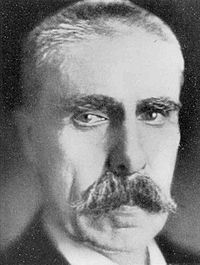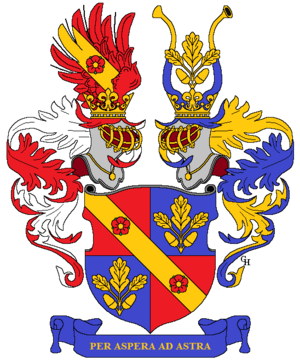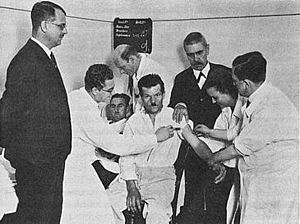Julius Wagner-Jauregg facts for kids
Quick facts for kids
Julius Wagner-Jauregg
|
|
|---|---|

Julius Wagner-Jauregg with his signature
|
|
| Born |
Julius Wagner
7 March 1857 |
| Died | 27 September 1940 (aged 83) |
| Nationality | Austrian |
| Other names | Julius Wagner |
| Alma mater | University of Vienna |
| Known for | Malariotherapy |
| Spouse(s) | Balbine Frumkin (divorced 1903) Anna Koch (married 1899) |
| Children | Julia and Theodor |
| Awards | Nobel Prize in Physiology or Medicine (1927) Cameron Prize for Therapeutics of the University of Edinburgh (1935) |
| Scientific career | |
| Fields | Pathology Psychiatry |
| Institutions | University of Vienna University of Graz State Lunatic Asylum at Steinhof |
| Thesis | L'origine et la fonction du coeur accélére (Origin and function of the accelerated heart) (1880) |
| Doctoral advisor | Salomon Stricker |
| Signature | |
Julius Wagner-Jauregg (born March 7, 1857 – died September 27, 1940) was an Austrian doctor. He won the Nobel Prize in Physiology or Medicine in 1927. He was the first psychiatrist to ever receive this award.
He won the Nobel Prize for finding a new way to treat a serious brain disease. This treatment involved giving patients a mild form of malaria. This helped to cure a condition called dementia paralytica.
Contents
Early Life and Education
Julius Wagner-Jauregg was born as Julius Wagner on March 7, 1857. His birthplace was Wels, in Upper Austria. His parents were Adolph Johann Wagner and Ludovika Jauernigg Ranzoni.
In 1883, his father received a special title from the Austro-Hungarian Empire. This title was "Ritter von Jauregg," which meant he became a noble. So, Julius's family name changed to "Wagner von Jauregg."
He kept this name until 1918, when the empire ended. After that, his family name became "Wagner-Jauregg." He went to school at the Schottengymnasium in Vienna.
From 1874 to 1880, he studied Medicine at the University of Vienna. He also worked with Salomon Stricker there. In 1880, he earned his doctorate degree. His main project was about how the heart speeds up.
His Career and Research
After finishing his studies, Julius Wagner-Jauregg started doing experiments. He worked with animals in a lab, which was not common back then. From 1883 to 1887, he worked at a clinic that focused on mental health.
In 1889, he took over from a famous doctor, Richard von Krafft-Ebing. This was at the Neuro-Psychiatric Clinic of the University of Graz. Here, he began studying Goitre and cretinism, which are conditions related to the thyroid gland. He also researched iodine.
In 1893, he became a special professor in Vienna. He was in charge of the Clinic for Psychiatry and Nervous Diseases. One of his students and helpers during this time was Constantin von Economo.
Later, in 1902, Wagner-Jauregg moved to another mental health clinic. In 1911, he returned to his old job. In 1935, he received an award from the University of Edinburgh.
Winning the Nobel Prize
Julius Wagner-Jauregg spent much of his life working on a special treatment. This treatment involved causing a fever in patients. This method is called pyrotherapy. He thought that fevers could help treat mental illnesses.
In 1887, he looked into how fevers affected mental health problems. He tried using diseases like erysipelas and tuberculin to cause fevers. But these treatments did not work very well.
Then, in 1917, he tried something new. He used malaria parasites to cause a fever. This worked very well for patients with dementia paralytica. This was a serious brain disease.
This amazing discovery earned him the Nobel Prize in Medicine in 1927. His main book about this was published in 1931. It was called Prevention and treatment of progressive paralysis by malaria inoculation.
This treatment was known as malariotherapy. However, it was quite risky. About 15% of patients died from it. Because of this, doctors no longer use malariotherapy today.
Later Life and Retirement
In 1928, Wagner-Jauregg retired from his job. But he stayed very active and healthy. He continued to publish almost 80 scientific papers. He died on September 27, 1940.
Many schools, roads, and hospitals in Austria are named after him.
His Views and Politics
Towards the end of his life, Julius Wagner-Jauregg was influenced by some harmful political ideas. These ideas were part of German nationalism, which was popular with Nazis. He showed support for the Nazi party after Germany took over Austria in 1938.
He believed in ideas about human races that were very harmful. He was the president of a group called the Austrian League for Racial Regeneration and Heredity. This group promoted ideas about "racial purity" that were part of Nazi beliefs.
However, after World War II, a special group in Austria looked into his past. They found that the Nazi party had actually refused his application to join. This was because his first wife, Balbine Frumkin, was Jewish.
See also
 In Spanish: Julius Wagner-Jauregg para niños
In Spanish: Julius Wagner-Jauregg para niños



